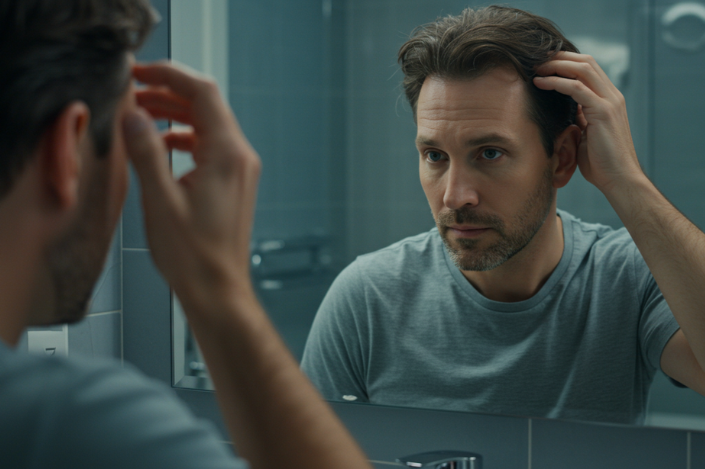Understanding PRP: What is Platelet-Rich Plasma?
Platelet-Rich Plasma (PRP) is a revolutionary treatment that utilises components of your own blood to promote healing and regeneration. Comprising a concentration of platelets, which are small blood cells that play a crucial role in healing, PRP is obtained by drawing a small amount of blood and processing it in a centrifuge. This separates the platelets from other components, resulting in a plasma rich in these potent cells.
The appeal of PRP lies in its natural origin and its ability to stimulate the body's healing mechanisms. It has been extensively used in medical fields such as orthopaedics, dentistry, and dermatology for its regenerative properties. When applied to the scalp, PRP is believed to revitalise hair follicles, encouraging hair growth and improving the overall health of your hair.
This treatment is particularly popular because it uses your own biological material, reducing the risk of allergic reactions or infections. Its non-surgical nature and minimal downtime make it an attractive option for those seeking a solution to hair loss without the need for invasive procedures.
The Science Behind PRP and Hair Growth
The science of PRP centres around the growth factors and proteins contained within platelets. These components are crucial in facilitating tissue repair and regeneration. When introduced into the scalp, PRP stimulates dormant hair follicles, effectively transitioning them from the resting phase to the active growth phase, known as the anagen phase.
The growth factors in PRP, such as vascular endothelial growth factor (VEGF) and platelet-derived growth factor (PDGF), enhance blood supply to the hair follicles. Improved circulation nourishes the follicles, providing them with the nutrients and oxygen they need to thrive. This process not only stimulates existing follicles but can also potentially revive those that have become inactive.
Scientific studies and clinical trials have shown promising results in using PRP for hair restoration. Although individual outcomes may vary, many patients experience a noticeable increase in hair density and thickness after undergoing PRP treatments. As research continues, the understanding of PRP's mechanisms and its efficacy in promoting hair growth continues to evolve.
Benefits of PRP for Hair Restoration
PRP offers numerous advantages for individuals seeking to restore their hair. One of the most significant benefits is its minimally invasive nature, making it an excellent choice for those hesitant about surgical interventions. With no incisions or stitches required, PRP treatment involves little to no recovery time, allowing you to resume your daily activities swiftly.
Additionally, PRP utilises your body's own cells, ensuring a natural and biocompatible approach to hair restoration. This reduces the risk of adverse reactions and makes it suitable for individuals with sensitivities to synthetic products. The treatment also offers a high degree of safety, as infections and complications are exceedingly rare due to the sterile procedure.
Another compelling benefit is the gradual and natural-looking results. Unlike some treatments that can lead to sudden, noticeable changes, PRP fosters a steady improvement in hair growth. This subtle enhancement makes it easier to maintain a natural appearance, avoiding the stigma sometimes associated with hair restoration procedures.
The PRP Treatment Process for Hair Growth
The process of undergoing PRP treatment for hair growth is straightforward and typically consists of several steps. Initially, a small sample of blood is drawn from your arm, similar to a routine blood test. This sample is then spun in a centrifuge to separate the platelets from other blood components, resulting in a concentrated PRP solution.
Once the PRP is prepared, it is carefully injected into the areas of the scalp where hair thinning or loss is most evident. The injections are strategically placed to target the affected follicles and promote optimal hair growth. While the idea of injections might seem daunting, the procedure is generally well-tolerated, with minimal discomfort reported by most patients.
The entire treatment session usually takes about 60 to 90 minutes, depending on the extent of the area being treated. Following the injections, you may experience slight redness or swelling, but these effects are temporary and typically subside within a day or two. Regular sessions are often recommended to achieve and maintain the best results, with follow-ups scheduled every few weeks or months as advised by your specialist.
What to Expect During PRP Hair Treatment
During the PRP hair treatment, you can anticipate a comfortable and relatively quick procedure. Prior to the session, a thorough consultation with your specialist will determine the specific areas to be targeted and the expected outcomes. Your scalp may be numbed with a topical anaesthetic to minimise any potential discomfort during the injections.
The actual injection process involves a series of small, precise injections into the scalp. While some individuals might feel a slight pinching sensation, the procedure is generally well-tolerated and not painful. The entire session is typically completed within an hour, allowing you to return to your daily routine almost immediately.
After the treatment, it's normal to experience slight tenderness or swelling in the treated areas. These effects are usually mild and subside quickly, typically within 24 to 48 hours. Your specialist will provide you with aftercare instructions to ensure optimal healing and results. It's important to adhere to any guidelines provided to maximise the benefits of the treatment.
PRP vs. Other Hair Loss Treatments
When it comes to addressing hair loss, PRP stands out for its natural approach and minimal invasiveness. Unlike surgical options such as hair transplants, PRP involves no incisions or recovery time, making it a convenient choice for those seeking non-surgical solutions. Furthermore, PRP utilises your own biological material, reducing the risk of adverse reactions associated with synthetic treatments.
Compared to topical treatments or medications, PRP offers the advantage of targeting the root cause of hair loss by revitalising hair follicles. While topical solutions may require daily application and can sometimes have limited effectiveness, PRP treatments are typically shorter in duration and require less frequent maintenance.
Additionally, PRP can be combined with other treatments to enhance their effectiveness. For instance, it can be used alongside hair transplant surgery to improve healing and promote better graft survival. When considering different options for hair restoration, PRP's unique benefits and versatility make it an appealing choice for many individuals.
Who is a Good Candidate for PRP Hair Treatment?
PRP hair treatment is suitable for a wide range of individuals experiencing hair thinning or loss. It is particularly effective for those in the early stages of hair loss or those with areas of thinning hair. Additionally, individuals with androgenic alopecia, also known as male or female pattern baldness, can benefit from PRP treatments.
However, it is essential to have realistic expectations regarding the outcomes of PRP treatment. While it can significantly improve hair density and thickness, it may not be as effective for individuals with severe hair loss or complete baldness. A thorough consultation with a qualified specialist will help determine if PRP is the right option for you.
Patients with underlying health conditions or scalp infections should consult their healthcare provider before undergoing PRP treatment. Additionally, individuals on certain medications or with a history of blood disorders may need to discuss their suitability for PRP with their doctor. Overall, PRP is a versatile treatment with a high safety profile, making it accessible to many individuals seeking hair restoration solutions.
Side Effects and Risks of PRP for Hair Growth
While PRP is generally considered safe, it is important to be aware of potential side effects and risks associated with the treatment. The most common side effects include temporary redness, swelling, or bruising at the injection sites. These effects are usually mild and resolve within a few days.
In rare cases, individuals may experience an allergic reaction to the components used in the PRP preparation, although this is uncommon due to the use of your own blood. It's crucial to disclose any allergies or sensitivities to your specialist before treatment to minimise any potential risks.
As with any medical procedure, there is a slight risk of infection, although this is extremely rare when the procedure is performed by a qualified professional in a sterile environment. Choosing an experienced and reputable PRP specialist is essential to minimise any risks and ensure a safe and effective treatment experience.
Take your first steps forward with PRP
PRP offers a promising solution for those seeking to restore their hair naturally and effectively. Its ability to harness the body's own regenerative capabilities makes it a unique and appealing option for hair growth. With minimal downtime and a high degree of safety, PRP is a versatile treatment that can benefit many individuals experiencing hair thinning or loss.
If you're considering PRP for hair restoration, it's essential to consult with a qualified specialist who can assess your suitability and provide personalised recommendations. With the right approach and guidance, PRP can help you achieve the fuller, healthier hair you've been seeking.
Ready to explore the benefits of PRP for your hair growth journey? Book your consultation today with a trusted PRP specialist and take the first step towards revitalising your hair and boosting your confidence.
For more Aesthetic Medispa content, head over to our Facebook.

